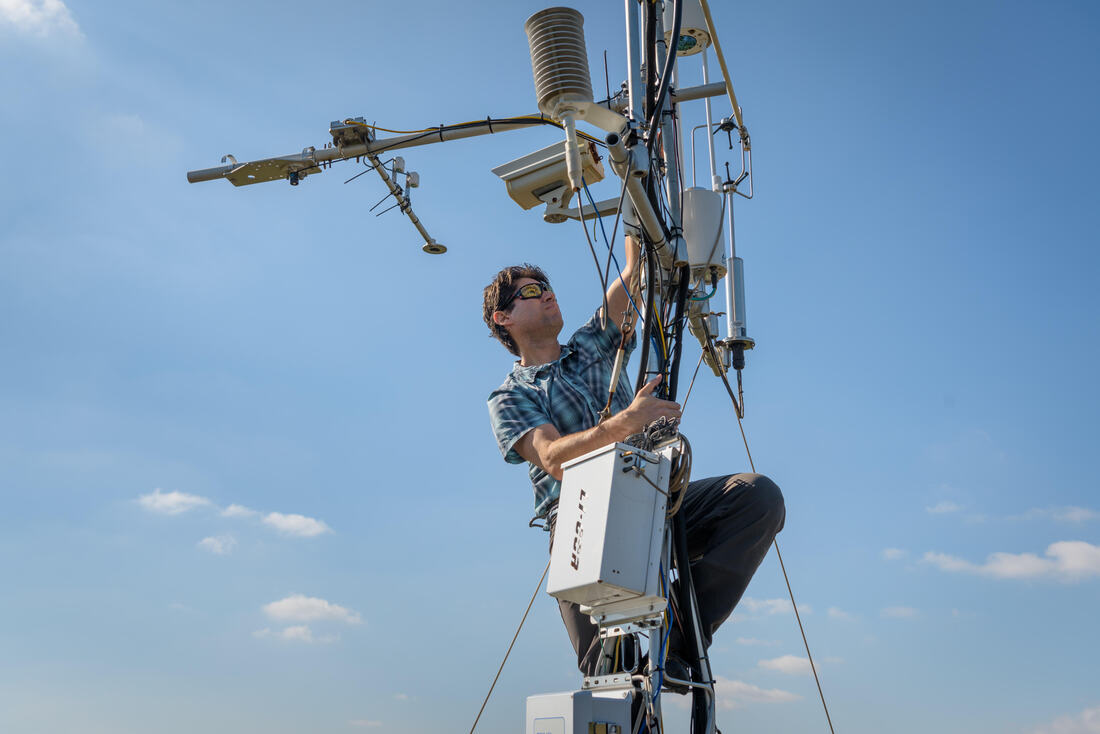As an ecosystem ecologist, I see ecohydrology within a broad extent as an approach to couple hydrological processes with other ecosystem processes across spatial and temporal scales. Ecohydrology enables us to think about water and energy fluxes and their sensitivity to changes in environmental conditions and anthropogenic management. Furthermore, ecohydrology is about coupling systems and processes but is increasingly important to add the role of human societies into the equation. I have used this perspective to research carbon and water dynamics from water-limited ecosystems to coastal wetlands where hydrological processes are contrasting and influence ecosystems in very different ways.
What are your undergraduate and graduate degrees in?
My undergraduate degree is a "Licenciatura" in Biology from Universidad Nacional Autónoma de Mexico (UNAM), Mexico. During this degree I was introduced to how water influences biogeochemical cycles as I did a study on nitrogen fixation by periphyton in a tropical wetland. I went to the University of California-Riverside, USA, to study a PhD in Environmental Science where I studied carbon dynamics in a water-limited ecosystem (California, USA) and a tropical forest (Yucatan, Mexico).
How did you arrive at working in/thinking about ecohydrology?
My first experience was as an undergraduate with a study about how hydrological seasonality influences nitrogen fixation by periphyton in a tropical wetland. I was amazed about how organisms can sustain temperatures >65 deg C with no access to water and reactivate their metabolism within hours after the first rain. During my PhD, I had the opportunity to work in a water-limited ecosystem and explore how water pulses regulate soil CO2 fluxes and mycorrhizae growth. In addition, I worked in a tropical forest and had the opportunity to study how plants and soils respond to a large wind (and water) disturbance caused by a category 4 hurricane (hurricane Wilma in 2005). After my PhD, I had the opportunity to continue working on ecohydrology across water-limited ecosystems in Baja California (Mexico), New Mexico (USA), Almeria (Spain), and with collaborative synthesis studies around the world. I moved to the University of Delaware in 2012 and I started studying a coastal wetland. Here, I have been introduced to a completely different approach for ecohydrology and the importance of hydrodynamics, and this ecosystem opened new challenges, learning and research opportunities. In a nutshell, I have studied how too much water, the scarcity of water, the timing of water pulses, and the quality of water influence biogeochemical cycles across different ecosystems.
What do you see as an important emerging area of ecohydrology?
I am excited about terrestrial-aquatic interfaces. As I said, I have had the opportunity to work on terrestrial ecosystems but the ecohydrological paradigms established for these ecosystems may not be fully applicable in wetlands and across the terrestrial-aquatic interface. Studying ecohydrology in these interfaces requires developing and application of new approaches; for example, we need to revisit how we measure mass (and energy) fluxes as we must consider vertical and lateral fluxes. We need to have closer collaborations among disciplines to integrate hydrodynamics with biogeochemical processes to better understand the response of terrestrial-aquatic interfaces to climate change. Furthermore, I strongly believe that we need to better communicate how ecohydrological processes impact human societies and how scientific understanding is useful for developing policies and management practice to secure a sustainable future.
Do you have a favorite ecohydrology paper? Describe/explain.
I would like to share two books that have influenced my vision on ecohydrology across ecosystems. One is about ecohydrology in water limited ecosystems that details the role of soil moisture on plant ecology (Rodríguez-Iturbe and Porporato, 2007). The other is about ecohydrology in estuaries which brings a completely different perspective by introducing the importance of water in mass transport and ecological processes in coastal ecosystems (Wolanski and Elliott, 2015). These are two very different approaches of ecohydrology but that need to be integrated for a better understanding of terrestrial-aquatic interfaces. Finally, there are many classic papers on ecohydrology that have been highlighted before, but I have been fascinated by the capacity of plants to access nutrients and roots from bedrock... mycorrhizal hypha can penetrate granite bedrock and extract nutrients and water to enable plants to survive seasonal drought (Egerton-Warburton et al 2003). The knowledge from water-limited ecosystems to coastal wetlands and the deep access of water and resources shows the complexity that ecohydrology brings to our understanding of ecosystems...so much fun and so much to do!
What do you do for fun (apart from ecohydrology)?
I enjoy hiking, trail running, and recently my wife and me have returned to indoor rock climbing with our son. I have also been doing Crossfit for the last 4 years...do not judge me!

 RSS Feed
RSS Feed